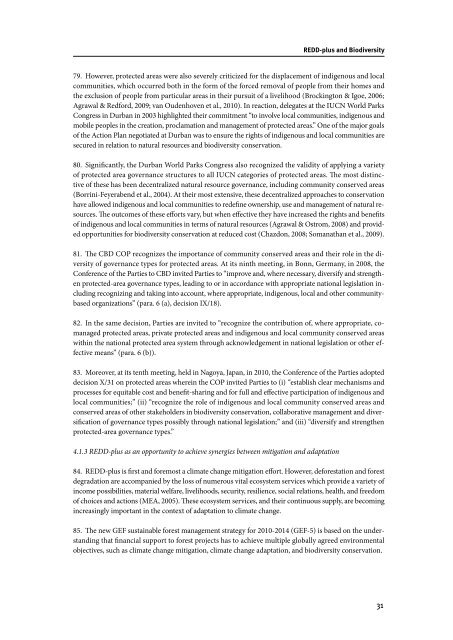REDD-plus and Biodiversity - Convention on Biological Diversity
REDD-plus and Biodiversity - Convention on Biological Diversity
REDD-plus and Biodiversity - Convention on Biological Diversity
You also want an ePaper? Increase the reach of your titles
YUMPU automatically turns print PDFs into web optimized ePapers that Google loves.
<str<strong>on</strong>g>REDD</str<strong>on</strong>g>-<str<strong>on</strong>g>plus</str<strong>on</strong>g> <str<strong>on</strong>g>and</str<strong>on</strong>g> <str<strong>on</strong>g>Biodiversity</str<strong>on</strong>g><br />
79. However, protected areas were also severely criticized for the displacement of indigenous <str<strong>on</strong>g>and</str<strong>on</strong>g> local<br />
communities, which occurred both in the form of the forced removal of people from their homes <str<strong>on</strong>g>and</str<strong>on</strong>g><br />
the exclusi<strong>on</strong> of people from particular areas in their pursuit of a livelihood (Brockingt<strong>on</strong> & Igoe, 2006;<br />
Agrawal & Redford, 2009; van Oudenhoven et al., 2010). In reacti<strong>on</strong>, delegates at the IUCN World Parks<br />
C<strong>on</strong>gress in Durban in 2003 highlighted their commitment “to involve local communities, indigenous <str<strong>on</strong>g>and</str<strong>on</strong>g><br />
mobile peoples in the creati<strong>on</strong>, proclamati<strong>on</strong> <str<strong>on</strong>g>and</str<strong>on</strong>g> management of protected areas.” One of the major goals<br />
of the Acti<strong>on</strong> Plan negotiated at Durban was to ensure the rights of indigenous <str<strong>on</strong>g>and</str<strong>on</strong>g> local communities are<br />
secured in relati<strong>on</strong> to natural resources <str<strong>on</strong>g>and</str<strong>on</strong>g> biodiversity c<strong>on</strong>servati<strong>on</strong>.<br />
80. Significantly, the Durban World Parks C<strong>on</strong>gress also recognized the validity of applying a variety<br />
of protected area governance structures to all IUCN categories of protected areas. The most distinctive<br />
of these has been decentralized natural resource governance, including community c<strong>on</strong>served areas<br />
(Borrini-Feyerabend et al., 2004). At their most extensive, these decentralized approaches to c<strong>on</strong>servati<strong>on</strong><br />
have allowed indigenous <str<strong>on</strong>g>and</str<strong>on</strong>g> local communities to redefine ownership, use <str<strong>on</strong>g>and</str<strong>on</strong>g> management of natural resources.<br />
The outcomes of these efforts vary, but when effective they have increased the rights <str<strong>on</strong>g>and</str<strong>on</strong>g> benefits<br />
of indigenous <str<strong>on</strong>g>and</str<strong>on</strong>g> local communities in terms of natural resources (Agrawal & Ostrom, 2008) <str<strong>on</strong>g>and</str<strong>on</strong>g> provided<br />
opportunities for biodiversity c<strong>on</strong>servati<strong>on</strong> at reduced cost (Chazd<strong>on</strong>, 2008; Somanathan et al., 2009).<br />
81. The CBD COP recognizes the importance of community c<strong>on</strong>served areas <str<strong>on</strong>g>and</str<strong>on</strong>g> their role in the diversity<br />
of governance types for protected areas. At its ninth meeting, in B<strong>on</strong>n, Germany, in 2008, the<br />
C<strong>on</strong>ference of the Parties to CBD invited Parties to “improve <str<strong>on</strong>g>and</str<strong>on</strong>g>, where necessary, diversify <str<strong>on</strong>g>and</str<strong>on</strong>g> strengthen<br />
protected-area governance types, leading to or in accordance with appropriate nati<strong>on</strong>al legislati<strong>on</strong> including<br />
recognizing <str<strong>on</strong>g>and</str<strong>on</strong>g> taking into account, where appropriate, indigenous, local <str<strong>on</strong>g>and</str<strong>on</strong>g> other communitybased<br />
organizati<strong>on</strong>s” (para. 6 (a), decisi<strong>on</strong> IX/18).<br />
82. In the same decisi<strong>on</strong>, Parties are invited to “recognize the c<strong>on</strong>tributi<strong>on</strong> of, where appropriate, comanaged<br />
protected areas, private protected areas <str<strong>on</strong>g>and</str<strong>on</strong>g> indigenous <str<strong>on</strong>g>and</str<strong>on</strong>g> local community c<strong>on</strong>served areas<br />
within the nati<strong>on</strong>al protected area system through acknowledgement in nati<strong>on</strong>al legislati<strong>on</strong> or other effective<br />
means” (para. 6 (b)).<br />
83. Moreover, at its tenth meeting, held in Nagoya, Japan, in 2010, the C<strong>on</strong>ference of the Parties adopted<br />
decisi<strong>on</strong> X/31 <strong>on</strong> protected areas wherein the COP invited Parties to (i) “establish clear mechanisms <str<strong>on</strong>g>and</str<strong>on</strong>g><br />
processes for equitable cost <str<strong>on</strong>g>and</str<strong>on</strong>g> benefit-sharing <str<strong>on</strong>g>and</str<strong>on</strong>g> for full <str<strong>on</strong>g>and</str<strong>on</strong>g> effective participati<strong>on</strong> of indigenous <str<strong>on</strong>g>and</str<strong>on</strong>g><br />
local communities;” (ii) “recognize the role of indigenous <str<strong>on</strong>g>and</str<strong>on</strong>g> local community c<strong>on</strong>served areas <str<strong>on</strong>g>and</str<strong>on</strong>g><br />
c<strong>on</strong>served areas of other stakeholders in biodiversity c<strong>on</strong>servati<strong>on</strong>, collaborative management <str<strong>on</strong>g>and</str<strong>on</strong>g> diversificati<strong>on</strong><br />
of governance types possibly through nati<strong>on</strong>al legislati<strong>on</strong>;” <str<strong>on</strong>g>and</str<strong>on</strong>g> (iii) “diversify <str<strong>on</strong>g>and</str<strong>on</strong>g> strengthen<br />
protected-area governance types.”<br />
4.1.3 <str<strong>on</strong>g>REDD</str<strong>on</strong>g>-<str<strong>on</strong>g>plus</str<strong>on</strong>g> as an opportunity to achieve synergies between mitigati<strong>on</strong> <str<strong>on</strong>g>and</str<strong>on</strong>g> adaptati<strong>on</strong><br />
84. <str<strong>on</strong>g>REDD</str<strong>on</strong>g>-<str<strong>on</strong>g>plus</str<strong>on</strong>g> is first <str<strong>on</strong>g>and</str<strong>on</strong>g> foremost a climate change mitigati<strong>on</strong> effort. However, deforestati<strong>on</strong> <str<strong>on</strong>g>and</str<strong>on</strong>g> forest<br />
degradati<strong>on</strong> are accompanied by the loss of numerous vital ecosystem services which provide a variety of<br />
income possibilities, material welfare, livelihoods, security, resilience, social relati<strong>on</strong>s, health, <str<strong>on</strong>g>and</str<strong>on</strong>g> freedom<br />
of choices <str<strong>on</strong>g>and</str<strong>on</strong>g> acti<strong>on</strong>s (MEA, 2005). These ecosystem services, <str<strong>on</strong>g>and</str<strong>on</strong>g> their c<strong>on</strong>tinuous supply, are becoming<br />
increasingly important in the c<strong>on</strong>text of adaptati<strong>on</strong> to climate change.<br />
85. The new GEF sustainable forest management strategy for 2010-2014 (GEF-5) is based <strong>on</strong> the underst<str<strong>on</strong>g>and</str<strong>on</strong>g>ing<br />
that financial support to forest projects has to achieve multiple globally agreed envir<strong>on</strong>mental<br />
objectives, such as climate change mitigati<strong>on</strong>, climate change adaptati<strong>on</strong>, <str<strong>on</strong>g>and</str<strong>on</strong>g> biodiversity c<strong>on</strong>servati<strong>on</strong>.<br />
31

















